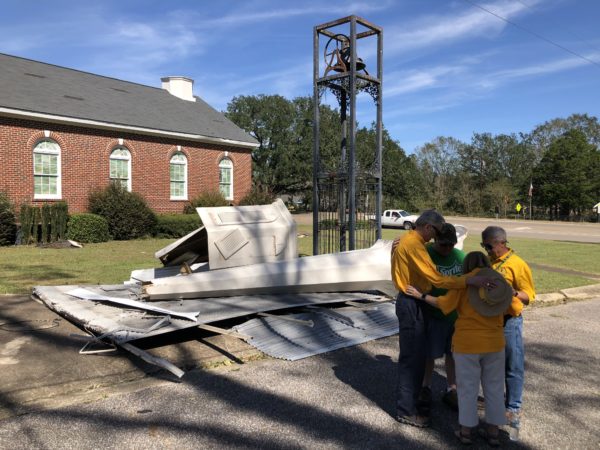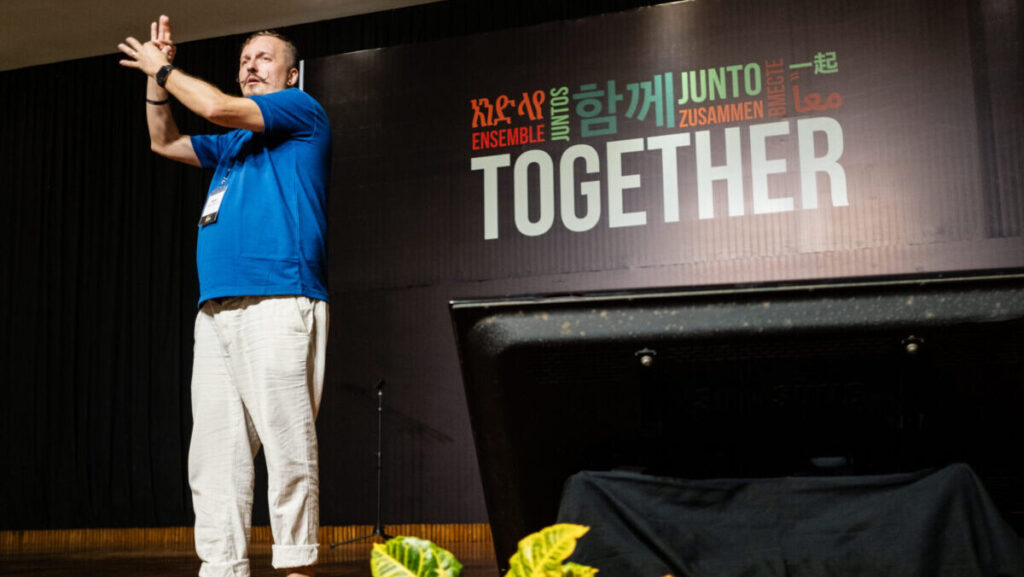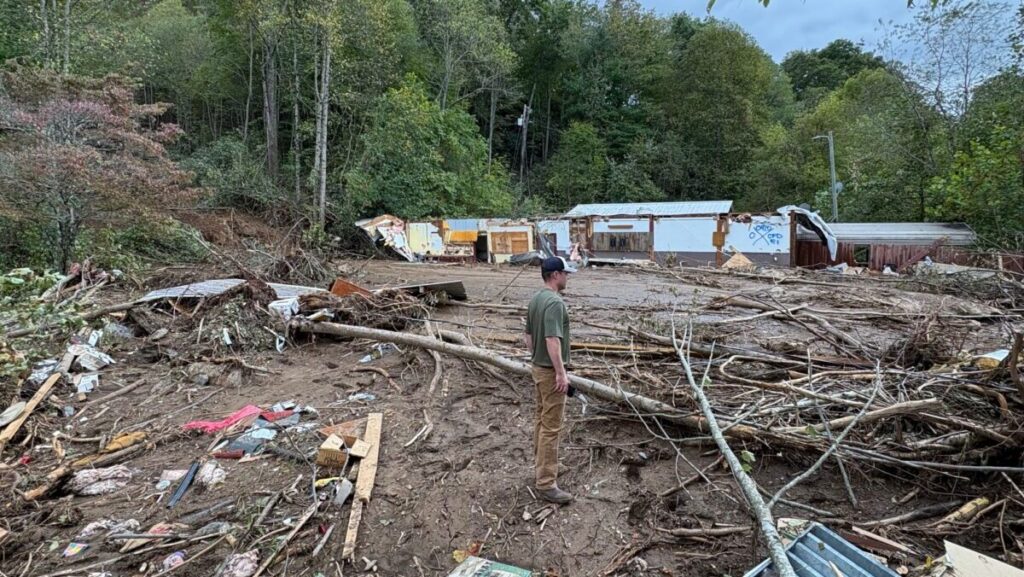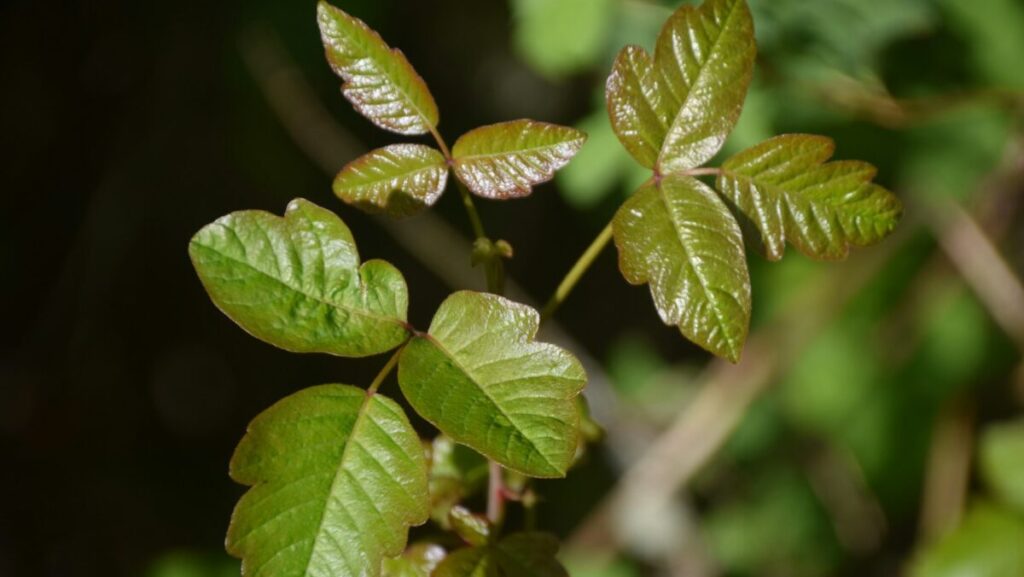In the small southern Alabama town of Cottonwood, the steeple of Cottonwood First Baptist Church lay in twisted pieces in the church yard. Less than a block away, the visitor’s bleachers at Cottonwood High School’s football stadium were upside down on the field.
Throughout the community, downed trees and power lines told the story of Hurricane Michael’s destructive path through the southeastern corner of Alabama.
But as neighbors checked on neighbors and first responders in the region rescued people trapped in their homes, residents expressed gratitude that no lives were lost and praised the work of emergency personnel as the cleanup began.
John Thomas, associational missionary/director of missions for Southeast Alabama Baptist Association (SABA), received more than 175 requests for disaster relief assistance following the storm. His Facebook post was shared nearly 3,000 times in 24 hours, and there was no shortage of work to be done.
SABA volunteers cooked at area shelters and started pulling together resources. A chainsaw team from Salem-Troy Baptist Association got to work in Dothan.
A feeding unit from Morgan Baptist Association was deployed to feed people in shelters and others in the area. A command center was set up at Ridgecrest Baptist Church, Dothan, and additional resources were being called out as needs were being assessed, said Mark Wakefield, disaster relief (DR) strategist for the Alabama Baptist State Board of Missions (SBOM).
Wakefield said Alabama Baptist DR would focus on southeastern Alabama for the initial cleanup and would coordinate with DR partners in Florida and other states as cleanup and recovery continued.
Though property damage was great in southeastern Alabama, the destruction was worse along the Florida Gulf Coast.
Michael tore through beach communities and inland areas with its powerful wind, storm surge and heavy rains. One day after Michael’s destructive landfall, Florida Gov. Rick Scott called the storm “an absolute monster.”
Damage assessment
“The damage left in its wake is still yet to be fully understood,” Scott told NBC News.
As of Oct. 12, 11 deaths were attributed to the storm: four in Florida, one in Georgia, one in North Carolina and five in Virginia, where the remnants of Michael brought flash flooding before moving back into the Atlantic Ocean.
Brock Long, administrator of the Federal Emergency Management Agency (FEMA), told CNN the death toll would likely climb in Florida as rescue workers sifted through damaged homes.
“I expect the fatality count to come up today. I expect it to come up tomorrow as well, as we get through the debris,” Long said. “Hopefully it doesn’t rise dramatically, but it is a possibility.”
Record-setting storm
Hurricane Michael made landfall just west of Mexico Beach, a community in the Florida Panhandle shortly after noon Central time Oct. 10. With winds near 155 miles per hour, Michael was a strong category 4 storm, and the strongest hurricane to ever hit the Florida Panhandle, according to the U.S. National Weather Service.
Michael was a record-setting storm, with an all-time low sea level pressure recorded at Panama City, Florida. Rainfall amounts in excess of six inches fell in Georgia, South Carolina and North Carolina.
Several Florida beach communities including Panama City and Mexico Beach were devastated by the storm’s fierce winds and flood waters. Entire neighborhoods were flattened as the storm came ashore.
Southeast Alabama also received extensive damage as the eye passed near Gordon in Houston County as a Category 3 hurricane.
Dothan mayor Mark Saliba called the storm “an unprecedented catastrophic event.”
The Dothan Eagle reported that thousands of trees were toppled in winds ranging from 60 to 90 miles per hour.
Brian Hastings, director of Alabama Emergency Management, said the storm left 92,000 residents without power. Crews from area electricity providers were working diligently at press time to restore service.
In Florida millions were without power and water. FEMA had teams on the ground assessing damage and doing search and rescue. Florida Baptist Disaster Relief (FBDR) teams were staging to respond once federal and state agencies gave the go-ahead, said Tommy Green, executive director of the Florida Baptist Convention.
“We are committed as churches in Florida to come right beside these communities and churches,” Green said.
Keila Diaz, digital communication assistant for the Florida Baptist Convention, reported Oct. 11 that a team of 20 volunteers led by Marvin Corbin, logistics and field missionary for FBDR was on the way to Tallahassee with equipment and supplies.
“There are already clean-up and recovery teams on the ground in Wakulla and Panacea near Lake Ellen,” he said, adding that there was a team in Panama City doing a windshield assessment. “They are driving through seeing where the most damage is, where to focus efforts, evaluating what can be salvaged and what is a total loss.”
Green said the level of devastation was “incredible,” with homes, churches and businesses damaged. Several police and fire stations lost their roofs or sustained significant structural damage.
Diaz reported that several Florida Baptist churches sustained heavy damage as a result of the storm including roof loss, structural damage and flooding. Some of the churches are Family of God Church, both Panama City campuses; First Baptist Church, Port Saint Joe; First Baptist Church, Lynn Haven; First Baptist Church, Panama City; and Hiland Park Baptist Church, Panama City.
“Just about every church has had some level of damage,” said Lewis Miller, west Florida regional catalyst for the Florida Baptist Convention. “It’s going to be a long, long time of recovering and rebuilding.”
The Baptist College of Florida in Graceville also had moderate to severe structural damage but no one was injured.
How to help
Mark MacDonald, strategic communication catalyst for the Florida Baptist Convention, said disaster relief updates would be posted at www.FLBaptist.org as cleanup and recovery continues. Disaster relief strategists in Florida discourage material goods donations because logistics for accommodating them would complicate disaster response.
Wakefield has noted in the past that ABDR does not collect and distribute donated goods. Churches and individuals who wish to send items such as cleaning supplies, bottled water, clothing or other necessities should coordinate with a specific church or organization who is willing and able to accept the donations, he said.
Those wishing to help with hurricane relief efforts are urged to give through ABDR at www.sbdr.org, where every dollar given is used toward disaster relief efforts.






Share with others: